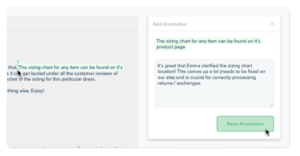CSAT Scores: How to Measure and Improve the Customer Service Experience
After any customer touchpoint, there are countless insights you could gather to better understand their overall experience. Customer satisfaction (CSAT) scores are a valuable tool, measured to help businesses gauge customer sentiment after different interactions with your brand. CSAT is typically used by many stakeholders to understand the customer experience across various touchpoints. Customer service teams specifically use CSAT to gain insights into their service quality. In this article, we’ll explore how customer service and customer experience teams can measure and improve CSAT to enhance their service level.
What is CSAT
CSAT is a measure of customer sentiment used to help organizations understand their customers’ reactions to products and services.
After a transaction or interaction, customers are asked to answer a question rating their satisfaction level on a standard scale, typically ranging from very satisfied to not satisfied at all.
For contact center leaders, this measure helps track service performance over time and identify areas for improvement.
How Is a CSAT Score Calculated?
A CSAT score is calculated taking the number of satisfied customers (those who responded with “very satisfied” or “somewhat satisfied”) divided by the number of survey responses, then multiplied by 100 to convert to a percentage. This score provides an understanding of overall customer sentiment towards your product or service, indicating the proportion of customers who are satisfied. Calculating CSAT scores accurately is crucial for any business aiming to glean meaningful insights from their customer feedback.
CSAT Score Calculation Formula
- Identify the total number of survey respondents.
- Determine the number of satisfied customers (those who responded with “very satisfied” or “somewhat satisfied”).
- Divide the number of satisfied customers by the total number of respondents.
- Multiply the result by 100 to convert it to a percentage.
This percentage represents your CSAT score.
Why Measure Agent-Level CSAT Matters
There are many points at which you can measure customer satisfaction, but for customer service leaders, the most valuable feedback comes immediately after every service interaction.
CSAT scores can help team leaders identify coaching opportunities to improve agent performance, give agents visibility into their individual performance to encourage self-correcting behavior, and provide a simple metric to share with executives.
These all work together to improve the customer experience and highlight your impact on the success of the business.
6 Ways to Improve Your CSAT Score
Improving your CSAT score not only means happier customers, but contributes to brand advocacy and increased purchases. As a result, improving customer satisfaction is an important initiative for every contact center. Here are five strategies to help improve your CSAT score and drive customer retention:
1. Collect Comments
Feedback requests and surveys should be concise. Include a few multiple-choice questions and leave room for open-ended feedback. Any comments you receive will offer clear direction on next steps and asking for feedback shows the customer that their voice is valued.
2. Include a Follow-Up Question
After a customer submits their CSAT rating, you might include a follow-up question asking them to identify areas of agent excellence or opportunities for improvement. The answers you receive will offer specific insights into what your customers are looking for.

3. Democratize the Data
Empower agents to self-correct by giving them direct visibility into customer feedback. With access to individual dashboards and real-time feedback streams, agents can easily identify what’s working with their customers, and what’s not.
4. Provide Real-Time Coaching
Set up alerts to flag opportunities for improvement and take immediate action to coach agents on how to better address issues in the future.
With modern customer feedback tools, you can easily set up alerts to flag negative feedback, leave comments or annotations within a ticket, and deliver in-the-moment coaching throughout the day.
When you let CSAT scores guide your coaching efforts, you’ll never miss another opportunity for improvement.

5. Act on Low Ratings Right Away
Implement a service recovery strategy to improve customer sentiment in real-time and salvage the relationship. CSAT is a crucial metric for customer experience teams to understand not only how they are doing, but how they can do better. Even if you’re already measuring CSAT, use the steps above to establish processes that will take your scores to the next level.
6. Use Technology to Improve CSAT Score
Contact center and customer experience tools, can help your organization identify patterns and trends in customer feedback, enabling your team to optimize strategies more effectively. Embracing these technologies can drive a more seamless and efficient customer service experience, leading to higher CSAT scores.
Analyzing Your CSAT Score
Analyzing and interpreting CSAT scores is an essential part of any customer service strategy. By contextualizing these scores within the broader scope of customer feedback and overall business objectives, you can gain actionable insights into your service quality and areas for improvement.
Interpreting CSAT Score Results
CSAT scores can range from 0 to 100, with higher scores indicating a greater degree of customer satisfaction. Here’s a simple way to interpret different score ranges:
- 90 – 100: Excellent
- 70 – 89: Good
- 50 – 69: Average
- Below 50: Poor
Benchmarking Your CSAT Score
Benchmarking your CSAT score against industry standards can provide valuable insight into your performance in customer service. It’s essential to compare your scores with businesses in your industry to get a more accurate picture of your performance.
Common CSAT Score Mistakes
- Over-relying on CSAT scores: Many brands make the mistake of solely relying on CSAT scores to gauge customer satisfaction. While CSAT scores are helpful, they should not be the only data or metric used to evaluate your customer experience.
- Misinterpreting the results: CSAT scores provide a snapshot of customer sentiment, but they can be misinterpreted if not analyzed properly. It’s important to consider other metrics and feedback to gain a more comprehensive understanding of the customer experience.
- Using CSAT scores in isolation: DISTRIBUC
By avoiding these common mistakes, businesses can better understand and improve the overall customer satisfaction.
Boost Your Customer Service Experience with Medallia
Our innovative contact center and customer experience solutions allow you to better understand and engage with your customers effectively, enhancing their experience and satisfaction. Offering streamlined omnichannel support and tailored personalization capabilities, Medallia empowers you to meet and exceed evolving customer expectations. Contact us today and start improving your CSAT scores for a better customer service experience.









